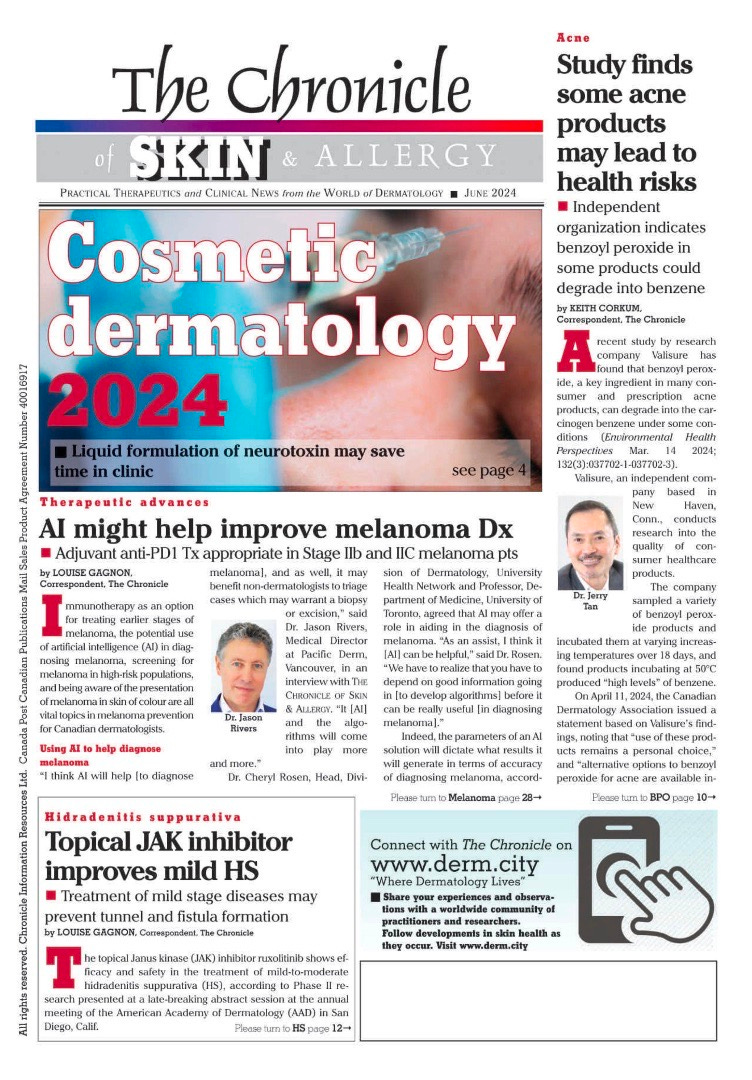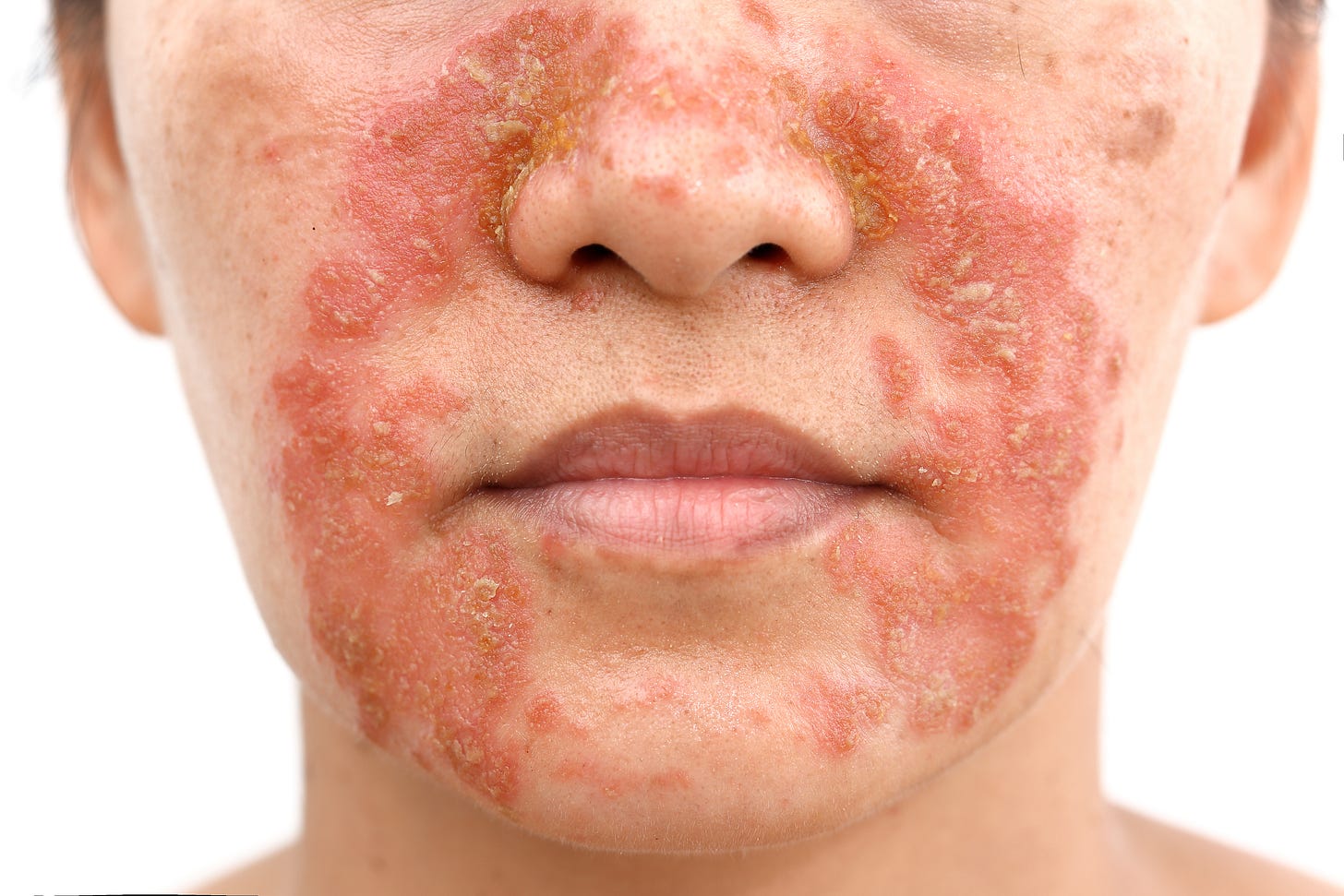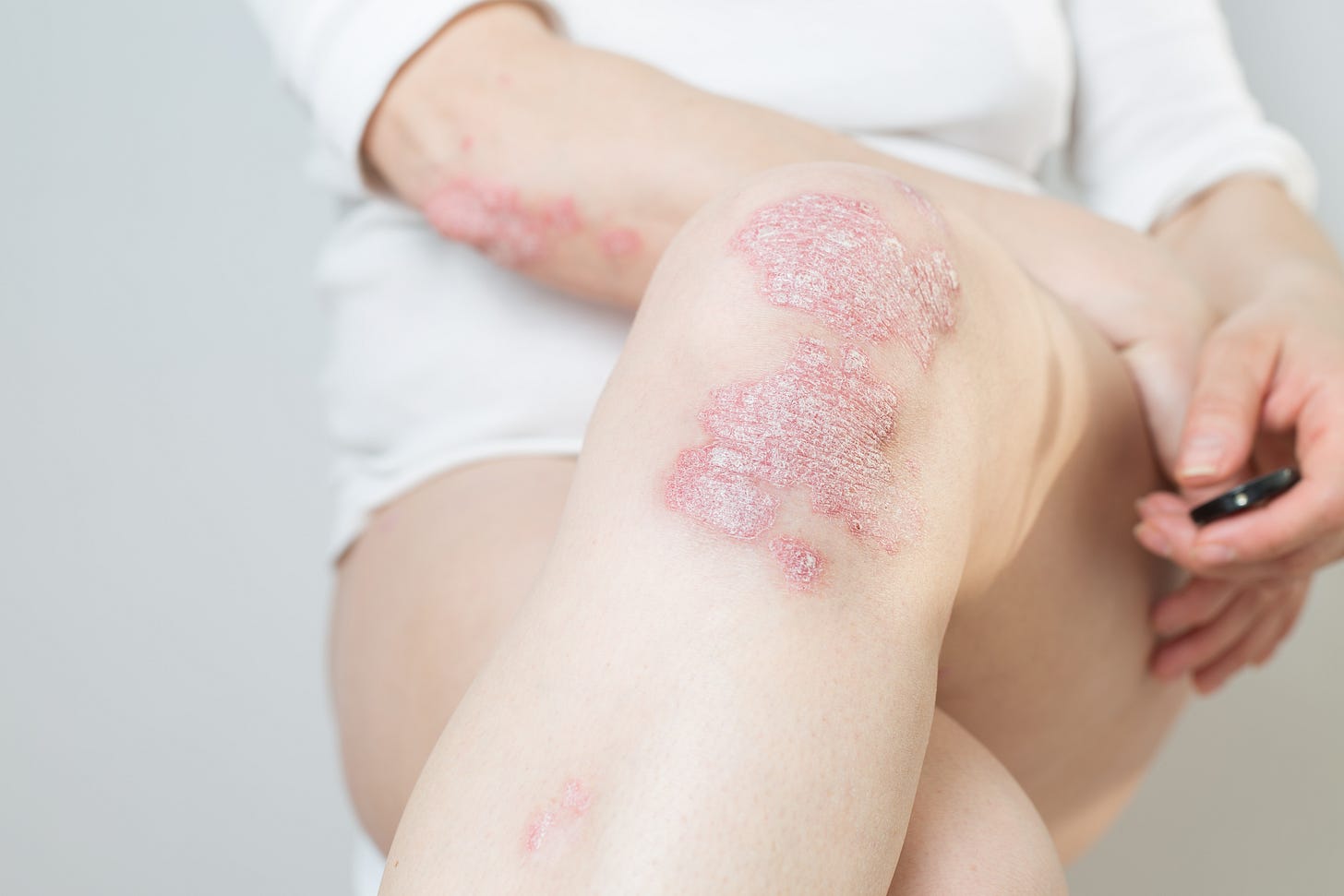Effectiveness of bimekizumab for genital, nail, and scalp psoriatic lesions
Today's report also covers efficacy of tildrakizumab, blood-count-derived inflammatory markers, and more (1,750 words, 7 minutes, 10 seconds)
The Vender on Psoriasis e-newsletter is supported by an unrestricted grant from Sun Pharma Canada
Good morning and welcome to the fifteenth issue of Special Reports: Skin Spectrum Weekly presents “Vender on Psoriasis.” This series is based on Dr. Vender’s popular column appearing in each edition of The Chronicle of Skin & Allergy, which offers expert commentary and opinions on current clinical developments in PsO. We’d love to get your feedback and suggestions and invite you to be in touch. Please write to us at health@chronicle.org

Effectiveness of bimekizumab for genital, nail, and scalp psoriatic lesions
This retrospective study from Japan evaluated the effectiveness of bimekizumab, an IL-17A and IL-17F inhibitor, in treating genital, nail, and scalp psoriasis over 24 weeks in a real-world clinical setting. The study (J Dermatol 2024; doi:10.1111/1346-8138.17427) included 52 Japanese patients with moderate-to-severe psoriasis treated with bimekizumab between May 2022 and Feb. 2024.
The therapeutic effects were assessed using Physician's Global Assessment (PGA) scores for genital (genital-PGA), fingernails (PGA-F), scalp (ss-PGA), and whole body (sPGA), as well as the Dermatology Life Quality Index (DLQI). The achievement rates of PGA 0/1 (clear/almost clear) for each site and DLQI 0/1 were evaluated at weeks 4, 16, and 24.
Results showed significant improvements across all sites:
- Genital-PGA 0/1 achievement rates: 66.7% (week 4), 96.3% (week 16), 96.2% (week 24)
- PGA-F 0/1 achievement rates: 16.1% (week 4), 46.4% (week 16), 66.7% (week 24)
- ss-PGA 0/1 achievement rates: 69.2% (week 4), 97.1% (week 16), 93.9% (week 24)
- sPGA 0/1 achievement rates: 61.2% (week 4), 84.1% (week 16), 92.3% (week 24)
- DLQI 0/1 achievement rates: 44.4% (week 4), 77.8% (week 16), 83.3% (week 24)
The study noted that genital and scalp psoriasis showed more rapid improvement compared to nail psoriasis. The effectiveness of bimekizumab in treating these difficult-to-treat areas was comparable to or better than previous studies with other biologics, such as ixekizumab.
Regarding safety, treatment-emergent adverse events (TEAEs) were reported in 19 patients (33.9%), with no serious adverse events or deaths. The most common TEAEs were pruritus (8.9%), oral candidiasis (7.1%), and dyshidrotic eczema (7.1%). Four patients (7.1%) discontinued treatment due to adverse events.
The study concluded that bimekizumab effectively improved genital, nail, and scalp psoriasis, as well as patients’ quality of life, in a real-world setting. The safety profile was consistent with previous clinical trials, with no new adverse events observed.
Limitations of the study included its single-centre design, small sample size, short duration, and lack of a control group. The authors suggest that longer-term studies are needed to further evaluate the effectiveness of bimekizumab, especially for nail psoriasis.
Comment: This retrospective study from Japan highlights the effectiveness of bimekizumab, an IL-17A and IL-17F inhibitor, in treating challenging areas of psoriasis—genital, nail, and scalp lesions. Over 24 weeks, significant improvements were observed, with rapid responses in genital and scalp psoriasis and more gradual improvement in nail psoriasis. The results suggest that bimekizumab is at least as effective, if not more so, than other biologics such as ixekizumab in these difficult-to-treat areas.
Safety data were consistent with previous trials, with no serious adverse events reported. However, the study’s limitations, including its small sample size and lack of a control group, call for longer-term studies to further validate these findings, particularly for nail psoriasis. Overall, bimekizumab appears to be a promising option for patients with moderate-to-severe psoriasis affecting these specific regions.

Efficacy of tildrakizumab 200 mg in difficult-to-treat patient populations
This Italian case series reports on the efficacy of tildrakizumab 200 mg in treating difficult-to-treat (DTT) patient populations with moderate to severe plaque psoriasis (Dermatol Rep 2024; doi: 10.4081/dr.2024.9999).
The authors present three cases of patients with complex psoriasis presentations who achieved complete remission following treatment with tildrakizumab 200 mg after failing prior therapies.
The first case involved a 37-year-old man with psoriasis localized in the pre-tibial/tibial region, previously treated with topical agents, methotrexate, and secukinumab. After losing response to secukinumab and experiencing partial response to risankizumab, the patient achieved complete remission with tildrakizumab 200 mg within seven months.
The second case described a 59-year-old woman with psoriasis on the trunk, limbs, and scalp, who had previously been treated with topical therapies, methotrexate, and adalimumab. After losing response to adalimumab, she achieved complete remission (PASI 0, BSA 0%, DLQI 0) within 16 weeks of starting tildrakizumab 200 mg.
The third case involved a 52-year-old man with severe plaque psoriasis (baseline PASI 45, DLQI 27) on the trunk and limbs, previously treated only with topical therapies due to comorbidities. He achieved complete remission (PASI 2, DLQI 1) after 16 weeks of tildrakizumab 200 mg treatment.
The authors highlight that while biologic agents are generally effective for moderate to severe plaque psoriasis, patients with DTT areas, high baseline PASI scores, or those who have failed prior treatments may show lower response rates. Tildrakizumab 200 mg is suggested as a potential option for these challenging cases, as indicated in its Summary of Product Characteristics for patients with high disease burden or body weight above 90 kg.
The paper discusses the challenges of treating psoriasis in DTT areas and managing patients who experience primary or secondary failure with biologic therapies. It references studies showing that tildrakizumab 200 mg may provide greater efficacy in patients with high disease burden and those who have failed prior biologic treatments.
While acknowledging the need for further comparative studies between tildrakizumab 100 mg and 200 mg in complex patient populations, this case series demonstrates the potential efficacy of the higher dose in patients with DTT psoriasis or high baseline PASI scores who have failed previous conventional and/or biologic treatments.
The authors conclude that tildrakizumab 200 mg may be an effective option for treating these challenging psoriasis cases, though more research is needed to directly compare the efficacy of different dosages in complex patient populations.
Comment: This Italian case series highlights the potential of tildrakizumab 200 mg in treating difficult-to-treat (DTT) psoriasis patients who have failed prior therapies. The three cases presented show significant improvement, with patients achieving complete remission after switching to tildrakizumab, despite having complex psoriasis presentations and high baseline PASI scores.
The study suggests that tildrakizumab 200 mg may be particularly effective in patients with high disease burden or those who weigh over 90 kg, as indicated by its Summary of Product Characteristics. However, the need for further comparative studies between the 100 mg and 200 mg doses is emphasized to better understand the optimal use in complex patient populations.
Overall, this case series supports the consideration of tildrakizumab 200 mg as a viable option for challenging psoriasis cases, although more research is needed to confirm these findings and guide treatment decisions.

Blood-count-derived inflammatory markers as predictors of response to biologics and small-molecule inhibitors in psoriasis
This multicentre retrospective study examined the utility of blood-count-derived inflammatory markers in predicting response to biologics and small-molecule inhibitors in 240 bio-naïve patients with chronic plaque psoriasis (J Clin Med 2024; 13:3992). The study analyzed various markers including neutrophil-to-lymphocyte ratio (NLR), platelet-to-lymphocyte ratio (PLR), derived neutrophil-to-lymphocyte ratio (d-NLR), systemic immune inflammation index (SII), and aggregate index of systemic inflammation (AISI) at baseline, 3, 6, and 12 months. The highest number of patients underwent treatment with ixekizumab.
Key findings include:
1. All analyzed inflammatory markers varied significantly between visits (p<0.005).
2. PASI scores correlated positively with PLR, d-NLR, and SII, while the psoriasis scalp severity index (PSSI) score correlated with AISI and SIRI.
3. 65.83% of patients achieved PASI 90 at 6 months, with ixekizumab showing the highest response rate.
4. 32.08% of patients were classified as super-responders (PASI 100 at 6 months).
5. At 6 months, responders had significantly lower values of MLR, SII, SIRI, and AISI compared to non-responders (p<0.05).
6. Higher baseline d-NLR and SIRI values were independent predictors of super-responder status, though confidence intervals crossed 1, warranting cautious interpretation.
7. NLR showed significant variation in patients treated with IL-17 and IL-23 inhibitors.
The study demonstrates the potential of blood-count-derived inflammatory markers, particularly d-NLR and SIRI, as predictors of treatment response to biologics in psoriasis. These cost-effective and easily obtainable markers may aid in monitoring disease course and predicting treatment outcomes. However, the retrospective design and limited follow-up period are notable limitations. Further prospective studies with larger cohorts are needed to validate these findings.
Comment: This multicentre retrospective study underscores the potential of blood-count-derived inflammatory markers, particularly d-NLR and SIRI, as predictors of response to biologics and small-molecule inhibitors in bio-naïve psoriasis patients. The findings suggest that lower values of these markers correlate with better treatment outcomes, including higher rates of PASI 90 and PASI 100 achievement.
These markers, being cost-effective and easily accessible, could become valuable tools for monitoring disease progression and predicting patient responses to treatment. However, the study's retrospective nature and limited follow-up highlight the need for larger, prospective studies to confirm these results and refine their clinical application.

If you find the contents of this newsletter interesting, please check out the Vender on Psoriasis podcast. It’s available at Apple iTunes, Stitcher, Spotify, or wherever you get your podcasts.
Dr. Ron Vender is a Hamilton-based certified dermatologist with over 30 years of clinical practice experience and over 100 clinical trials in psoriasis. He is founder and director of Dermatrials Research Incorporated and Venderm Consulting, specializing in treatments and management solutions for individuals with psoriasis.
Subscribe to The Chronicle of Skin & Allergy
Established in 1995, The Chronicle of Skin & Allergy is a scientific newspaper providing news and information on practical therapeutics and clinical progress in dermatologic medicine.
To apply for a complimentary* subscription, please email health@chronicle.org with your contact information or click the link below.






